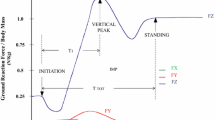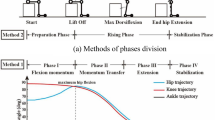Abstract
Background
Rising from a sitting position, or “sit-to-stand” (STS), is one of the basic activities in daily life. Therefore, studying the kinematics and kinetics of STS could help optimize STS movement strategy. This study analyzes the comprehensive influence of the handrail and foot position under the knee joint support on STS kinematics and kinetics.
Methods
A total of 30 young people were recruited to participate in this study. Their average age, height, weight, and BIM were 24.21 years old, 168.52 cm, 60.92 kg, and 21.46 kg/m2, respectively. The experiment was conducted under six experimental conditions. Total movement time, percent of movement time of each phase, trunk tilt angle, and peak joint moment were analyzed and compared. In addition, a correlation analysis was carried out between the range of motion of the joint angle and the peak joint moment.
Results
The results showed that the far handrail had the largest trunk tilt angle, and the smallest total moment impulse of the lower limb joints. The closer the foot was to the seat, the smaller the peak hip joint moment, and the larger the peak moment of ankle and knee joints, and a shorter total movement time.
Conclusions
The position of the handrail had a significant influence on the trunk tilt angle, percent of movement time of certain phase, and the total moment impulse of the lower limb joints. And the position of the foot had a significant influence on the peak moments of the ankle, hip, and knee joints.







Similar content being viewed by others
Data availability
The datasets used and/or analyzed for the current study are available from the corresponding author on reasonable request.
Abbreviations
- STS:
-
sit-to-stand
- AP:
-
anterior-posterior
- LSD:
-
least significant difference
References
Akram SB, McIlroy WE. Challenging horizontal movement of the body during sit-to-stand: impact on stability in the young and elderly. J Mot Behav. 2011;43(2):147–53.
Blache Y, Pairot de Fontenay B, Monteil K. The effects of seat height and foot placement on lumbar spine load during sit-to-stand tasks. Ergonomics. 2014;57(11):1687–95.
Chihara T, Fukuchi N, Seo A. Optimum position and orientation of handrail for sit-to-stand movement. J Adv Mech Des, Sys, Manuf. 2015;9, no. 3:JAMDSM0036–6.
Dekker D, Buzink SN, Molenbroek JF, de Bruin R. Hand supports to assist toilet use among the elderly. Appl Ergon. 2007;38(1):109–18.
Fleckenstein S, Kirby RL, MacLeod D. Effect of limited knee-flexion range on peak hip moments of force while transferring from sitting to standing. J Biomech. 1988;21(11):915–8.
Frykberg GE, Häger CK. Movement analysis of sit-to-stand – research informing clinical practice. Phys Ther Rev. 2015;20(3):156–67.
GB/T10000-88. Human dimensions of Chinese adults S. Beijing: Standards Press of China; 1988.
Gillette JC, Stevermer CA. The effects of symmetric and asymmetric foot placements on sit-to-stand joint moments. Gait Posture. 2012;35(1):78–82.
Y. Hirata, J. Higuchi, T. Hatsukari, and K. Kosuge, "Sit-to-stand assist system by using handrail and electric bed moving up and down," 2008 2nd IEEE RAS & EMBS International Conference on Biomedical Robotics and Biomechatronics, 187-192, 2008.
Inai T, Takabayashi T, Edama M, Kubo M. Relationship between movement time and hip moment impulse in the sagittal plane during sit-to-stand movement: a combined experimental and computer simulation study. Biomed Eng Online. 2018;17(1):48.
Kato T, Sekiguchi Y, Honda K, Izumi SI, Kanetaka H. Comparison of handrail reaction forces between two different handrails during sit-to-stand movement in the elderly. Clin Biomech (Bristol, Avon). 2020;80:105130.
Kawagoe S, Tajima N, Chosa E. Biomechanical analysis of effects of foot placement with varying chair height on the motion of standing up. J Orthop Sci. 2000;5:124–33.
Khemlani M, Carr J, Crosbie W. Muscle synergies and joint linkages in sit-to-stand under two initial foot positions. Clin Biomech. 1999;14(4):236–46.
Kinoshita S. Handrail position and shape that best facilitate sit-to-stand movement. J Back Musculoskelet Rehabil. 2012;25(1):33–45.
Kinoshita S, Kiyama R, Yoshimoto Y. Effect of handrail height on sit-to-stand movement. PLoS One. 2015;10(7):e0133747.
Lee SJ, Mehta-Desai R, Oh K, Sanford J, Prilutsky BI. Effects of bilateral swing-away grab bars on the biomechanics of stand-to-sit and sit-to-stand toilet transfers. Disabil Rehabil Assist Technol. 2019;14(3):292–300.
Liu M, et al. Effects of modified sit-to-stand training on balance control in hemiplegic stroke patients: a randomized controlled trial. Clin Rehabil. 2016;30(7):627–36.
W. Mathiyakom, J. L. McNitt-Gray, P. Requejo, and K. Costa, "Modifying center of mass trajectory during sit-to-stand tasks redistributes the mechanical demand across the lower extremity joints," Clin Biomech (Bristol, Avon)., 20, 1, 105-111, 2005.
McIntosh EI, Vallis LA. Performance during reactive handrail grasping during forward walking by young and older adults with and without prior knowledge of the direction of movement is correlated with grip strength. Exp Gerontol. 2021;151:111386.
O'Meara DM, Smith RM. The effects of unilateral grab rail assistance on the sit-to-stand performance of older aged adults. Hum Mov Sci. 2006;25(2):257–74.
Rb S, Hp K. Some biomechanical consequences of varying foot placement in sit-to-stand in young women. Scand J Rehabil Med. 1996;28:79–88.
Sanford JA, Arch M, Megrew MB. An evaluation of grab bars to meet the needs of elderly people. Assist Technol. 1995;7(1):36–47.
Sekiguchi Y, et al. Effects of shelf bar assistance on kinetic control during sit-to-stand in healthy young and elderly subjects. J Biomech. 2020;106:109822.
Takeda K, Katsuhira J, Takano A. Effects of handrail use during sit-to-stand in the third trimester. Int J Ind Ergon. 2009;39(6):988–94.
Talis V, Grishin A, Solopova I, Oskanyan TL, Belenky VE, Ivanenko Y. Asymmetric leg loading during sit-to-stand, walking and quiet standing in patients after unilateral total hip replacement surgery. Clin Biochem. 2008;23(4):424–33.
Winter D. Kinematic and kinetic patterns in human gait: variability and compensating effects. Hum Mov Sci. 1984;3:51–76.
Yamako G, Chosa E, Totoribe K, Fukao Y, Deng G. Quantification of the sit-to-stand movement for monitoring age-related motor deterioration using the Nintendo Wii Balance Board. PLoS One. 2017;12(11):e0188165.
Acknowledgements
The authors wish to acknowledge the financial support from the Key Project of Tianjin Natural Science Foundation (19JCZDJC33200).
Funding
The Key Project of Tianjin Natural Science Foundation (19JCZDJC33200)
Author information
Authors and Affiliations
Contributions
Conceptualization: Shuo Yang, Na Zhao, Shouwei Zhang, and Qiang Xue. Formal analysis: Na Zhao. Methodology: Shuo Yang and Qiang Xue. Supervision: Qiang Xue. Visualization: Shouwei Zhang
Corresponding author
Ethics declarations
Ethics approval and consent to participate
This study was approved by the Academic Ethics and Scientific Ethics Committee of the Academic Committee of Tianjin University of Science and Technology. All subjects provided informed consent prior to participation.
Consent for publication
Not applicable.
Competing interests
The authors declare no competing interests.
Additional information
Publisher’s Note
Springer Nature remains neutral with regard to jurisdictional claims in published maps and institutional affiliations.
Rights and permissions
Springer Nature or its licensor (e.g. a society or other partner) holds exclusive rights to this article under a publishing agreement with the author(s) or other rightsholder(s); author self-archiving of the accepted manuscript version of this article is solely governed by the terms of such publishing agreement and applicable law.
About this article
Cite this article
Yang, S., Zhao, N., Zhang, S. et al. Analysis of the effect of handrail and foot position on STS in healthy young adults with knee support. Res. Biomed. Eng. 39, 853–862 (2023). https://doi.org/10.1007/s42600-023-00310-x
Received:
Accepted:
Published:
Issue Date:
DOI: https://doi.org/10.1007/s42600-023-00310-x




